The bench press may seem simple at first glance. But nothing could be further from the truth.
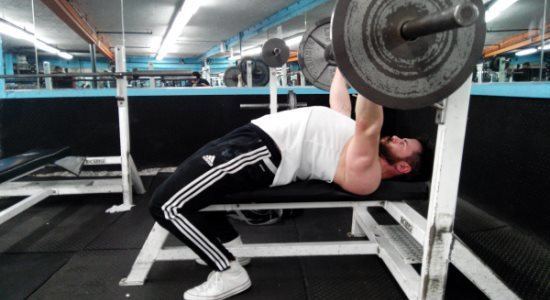
There’s a bunch of different things to think about when benching, including but not limited to:
- Shoulder blades together and down
- Upper back arched
- Elbows in
- Lats activated (when the bar is near the bottom of the range of motion)
- Breathe using the Valsalva maneuver
- Butt on the bench
- Leg drive
It’s that last point in the list above that I want to focus on today: leg drive.
Don’t know what leg drive is? In short, it involves using your leg strength to drive your feet/heels into the floor. This creates tension throughout your body, which gives you a stable base to press from.
Sounds simple, but it’s easier said than done. Even lifters who understand the concept and importance of leg drive will often execute it poorly.
So, I’ll share several practical tips and cues that (with practice) will help you use leg drive more effectively, and in turn, increase your bench press.
1. Use the Right Type of Weight Bench
Ideally, you should use a weight bench that’s around 16.5 – 17.5 inches tall from the floor to the top of the pad. The IPF requires for all benches in their powerlifting competitions to meet this spec because it’s the best height range for maximizing leg drive for most people.
If you’re benching inside a power rack, the bench should either be a flat weight bench, or an adjustable weight bench with minimal to no gap between the seat and back pad, if possible.
2. Initiate Leg Drive Before Lift-Off
Start using leg drive before you move the barbell. This will reinforce your back arch and keep your body stable on the bench.
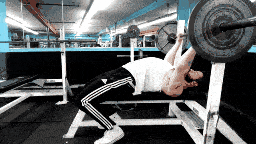

A common mistake many lifters make is waiting until after they unrack the bar to really initiate leg drive.
This messes up your position, causing you to use poor technique and waste valuable energy trying to get back into the correct position.
3. Press Your Heels Down, Then Drive
It’s not enough to just say “drive through your heels.” While accurate, that cue doesn’t fully describe what you should be trying to accomplish.
I find it more practical to say “press your heels down, then drive.”


The “press your heels down” part of this cue implies lowering your heels as far as possible before you really start driving with your legs.
This should occur during the setup – after arching your back and getting the right grip, but before unracking the bar.
Pressing the heels down puts your feet/ankles in a position that creates tension and the right leverages for generating more force when you fully initiate leg drive.
This cue is applicable whether you bench with your feet flat on the floor, or with your legs tucked and heel raised. Either way, you should lead with your heel, actively pressing it down into or toward the floor throughout the lift.
4. Drive Forcefully from Start of Rep; Increase Force as You Lower & Press
As I said in tip #1, you should start the lift using a good amount of leg drive – Consider this your baseline amount of leg drive during your set.
Gradually increase the force of your leg drive as you lower the bar to your chest.
Then, as you begin to press the weight up, drive your legs as explosively as possible until you get past your sticking point.
Gradually decrease leg drive intensity back to the baseline level as you lockout.
See the graph below for a visual representation of how leg drive should change throughout the lift.
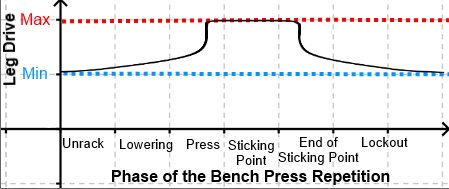

5. Never Disengage Leg Drive Between or During Reps
Once your feet are planted and you’re driving through your legs, don’t stop.
A common mistake you’ll see is people lifting up or shuffling their feet around during or between repetitions. This causes you to lose your tightness and gets you out of position. Not to mention, you screw up your tempo and waste valuable energy getting back into position.
If you find yourself doing this, find out why you’re doing it and then stop!
It may just be an unconscious need to move your lower body while your upper body is moving the weight. Simply becoming aware of what you’re doing should fix this.
Or, as was the case with me, it can result from having a poor setup position before liftoff, causing you to adjust your position mid-set. The solution is to improve your setup.
6. Squeeze Your Glutes Hard!
What major muscle group connects the upper body to the lower body?
The glutes, of course!
Now, what would happen if you don’t keep your glutes contracted while benching?
First off, there’d be less total leg drive force since your glutes contribute directly to that. Even more importantly, there would be a disconnect between your upper body and lower body…
…The tension created from pushing into the floor would not transfer efficiently to your upper body. Your back arch would be less profound and weaker, thereby reducing upper back tightness and creating a less stable base to bench off of.
The moral of the story here is to flex your butt muscles hard throughout your bench press set. Imagine trying to crack a walnut between your cheeks if you must 😀
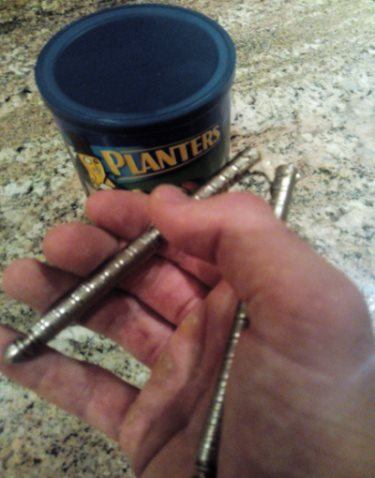

7. Imagine the Leg Drive Pushing Your Bodyweight onto Your Upper Back
Imagine driving into the ground and transferring force up your legs, through your torso and down into your upper back and shoulders…
…Visualize this force causing your bodyweight to shift from your legs and lower torso to your upper back.
Think of your bodyweight pushing your shoulder blades deep into the bench.
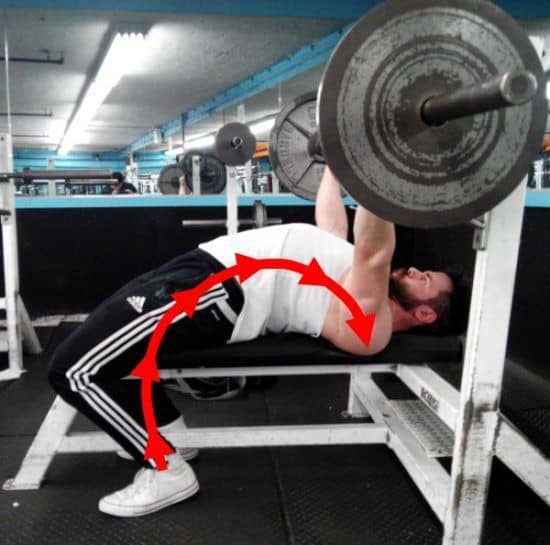

Of course, you’re not shifting your bodyweight, so much as your leg drive is stabilizing your torso and creating a tighter back arch. But who cares whether this visualization is accurate or not – What matters is that it improves your leg drive and helps you bench more.
8. Squeeze the Bench Between Your Thighs (for narrower stances only)
Note: This tip applies more to those with a medium to narrow bench press stance width. Obviously, those who use a wide stance are less able to squeeze the bench with their thighs since their legs are further apart.


Squeezing the bench with your inner thighs activates your leg musculature (particularly the adductors, hamstrings and glutes) more intensely.
The harder you contract your leg muscles, the greater the force you exert when driving your legs during the bench press.
There are other, less direct benefits of squeezing the bench between your thighs…
…For one, you’ll find that this helps prevent your butt from lifting up off the bench. Secondly, it improves your stability because your thighs are essentially anchoring your body to the bench.


9. Try Benching in Olympic Weightlifting Shoes
Note: This tip only applies to you if you keep your heels on the floor while benching. If you bench with your heels raised, ignore this.
Olympic weightlifting shoes afford you an increased range of motion in terms of being able to move your feet further back (i.e. under or behind your knees) without your heels rising off the floor.
The raised heel also puts your ankles at an angle that allows you to direct more force through your heels.
Additionally, these shoes allow you to transfer the force from your legs directly into the floor without loss of energy, thanks to the non-compressible soles.
10. Do Glute Bridges or Hip Thrusts for Assistance Work
One of the best ways to improve leg drive on bench press is…wait for it…to practice leg drive. Go figure, eh?
Thankfully, there are exercises that mimic the same position and train the muscles used during leg drive.
These exercises are glute bridges and hip thrusts, which can be done with bodyweight or with added weight.
By adding these exercises to your routine as assistance work, you’re getting better and stronger at leg drive because you’re practicing it under a load.


